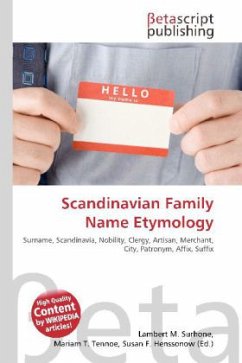
Scandinavian Family Name Etymology
Versandkostenfrei!
Versandfertig in 6-10 Tagen
23,99 €
inkl. MwSt.

PAYBACK Punkte
12 °P sammeln!
Please note that the content of this book primarily consists of articles available from Wikipedia or other free sources online. Heritable family names were generally adopted rather late within Scandinavia. Nobility were the first to take names that would be passed on from one generation to the next. Later, clergy, artisans and merchants in cities took heritable names. Familily names were used still used together with primary patronyms (father''s name plus an affix denoting relationship), which were used by all social classes. This meant that most families until modern times did not have an act...
Please note that the content of this book primarily consists of articles available from Wikipedia or other free sources online. Heritable family names were generally adopted rather late within Scandinavia. Nobility were the first to take names that would be passed on from one generation to the next. Later, clergy, artisans and merchants in cities took heritable names. Familily names were used still used together with primary patronyms (father''s name plus an affix denoting relationship), which were used by all social classes. This meant that most families until modern times did not have an actual family surnames as we know them today. Scandinavian patronyms were generally derived from the father''s given name with the addition of a suffix meaning ''son'' or ''daughter''. This naming tradition remained commonly used throughout the Scandinavian countries at the time of surname formation. The patronymic suffix -sen has also been in use in the area formerly speaking Middle Low German. Examples include names as Jansen, Thiessen, Thyssen and Hensen in Germany and Klaassen and Nelissen in the Netherlands.












